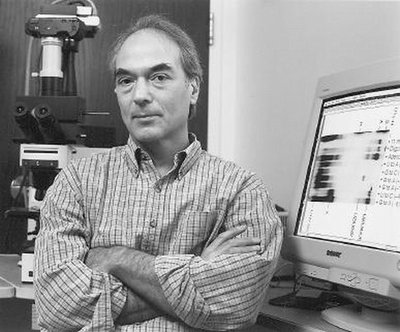January 17, 2002
Reading the genome: Biochemistry chair investigates how cells manage to express genes and replicate at the same time
By Pamela Wyngate
HS News & Community Relations
Stretch the DNA contained in one human cell from end-to-end, and it would be about one yard long. Yet that DNA has to fit into a cell nucleus, measuring a mere 10 microns across. If the name of the game is to get said DNA inside a ridiculously small nucleus, why doesn’t the cell use the Boy Scout rucksack method — simply roll the DNA into a very tight ball and stuff it inside the nucleus?
“It’s an engineering challenge,” says Dr. Alan Weiner, professor and chair of biochemistry. “It’s one of these miniaturization questions. How do they make the chip in your laptop? People like machinery, and this is just very, very small machinery — we want to know how it works.”
The problem with a tight ball of DNA is that cells must be able to gain access to (“read”) many specific regions of the immense DNA molecule where genes reside. It would be hopelessly time-consuming to unwind an entire ball of DNA every time the cell needed to “read” a specific gene. Instead, the DNA in each cell is arranged in something analogous to a library, where each gene is a book. The books aren’t all open at once. As needed, the cell can remove one book at a time, read it, and put it back on the appropriate shelf. When the cell divides, it must compact the books — so it shuts them all, replicates the DNA, divides, and then opens up only those books that are required reading for the new cell’s specialized functions. For instance, liver cells read books on liver cell function and heart cells read books on heart function.
“The specific problem we work on is how cells go back and forth between reading specific genes and compacting all the DNA in preparation for cell division. You can think of the compacted state as a book with its cover closed—and the expanded state of the chromosome as an open book available for reading,” says Weiner. “As a result, the DNA is extremely compact and fits inside the nucleus, but the cell can get at any piece it wants, whenever it wants.”
“Reading books requires opening the DNA, and you can’t close the book unless you stop reading,” explains Weiner. “You might even think of cell division as tearing a mystery novel away from an intent reader who wants to finish the book when it’s time to divide…what does the cell have to do to tear the DNA away from the RNA polymerase that’s copying it into RNA?”
If chromosomes are not properly compacted — if the books aren’t closed before the cell divides — the chromosomes can break under the physical stress of cell division, and the breaks can sometimes lead to cancer.
“Breaks lead to chromosome translocations because broken chromosome ends are ‘sticky,'” says Weiner. “A sticky end tends to glue itself onto some other piece of DNA where it doesn’t belong. Then you end up with a chromosome that’s built of two pieces of DNA that shouldn’t be connected. The cell abhors a break in DNA. If it sees a break in DNA, it knows the break means trouble in the short run, and it fixes the break no matter what the long-term cost.”
Weiner sees his research as part of a larger confluence of work in three different areas that were once separate, highly specialized fields: chromosome structure, transcription and DNA repair.
“It’s been slow and steady, over the past 10 years,” he says. “What’s been happening is that those three fields have been coming together because all of them have made so much progress they can now see their interactions.
“People who used to study transcription of naked DNA in the test tube now work on chromatin, because they want to know how the proteins that package DNA affect the ability of the RNA polymerase to read the genome. People who study DNA repair now recognize that many cellular proteins do double duty in both transcription and repair. And people who work on chromosome structure no longer regard chromosomes as static but as a more fluid structure that is nearly remade once per cell division cycle. People still specialize, but perhaps not as much. You have to look over your shoulder all the time, because the scientific traffic patterns are no longer clear.”
Weiner presents “Human Chromosome Fragility: Role of Cockayne Syndrome Group B Protein (CSB) and p53” at the Science in Medicine lecture, Thursday, Jan. 24, at noon in A-420, Hogness Auditorium, Health Sciences Center. Everyone is welcome.
Weiner received a Ph.D. from Harvard University in 1973. From 1973 to 1974 he was a postdoctoral fellow in biochemistry at Stanford University with Dr. A. Kornberg, and from 1974 to 1976 he was a postdoctoral fellow at MIT with Dr. H.F. Lodish. In 1976, Weiner joined Yale University as assistant professor of biophysics and biochemistry; he became professor in 1984, with a joint appointment in genetics.
In 2000 Weiner was named professor and chair of biochemistry at the UW School of Medicine. Among his many achievements, Weiner was a co-author of the Molecular Biology of the Gene (4th edition) by Watson et al., editor-in-chief of the journal Molecular and Cellular Biology from 1990 to 2000, and chair of the NIH Molecular Biology Study Section from 1997 to 1999. He is on the editorial boards of the journals Cell, RNA and Molecular Cell.



